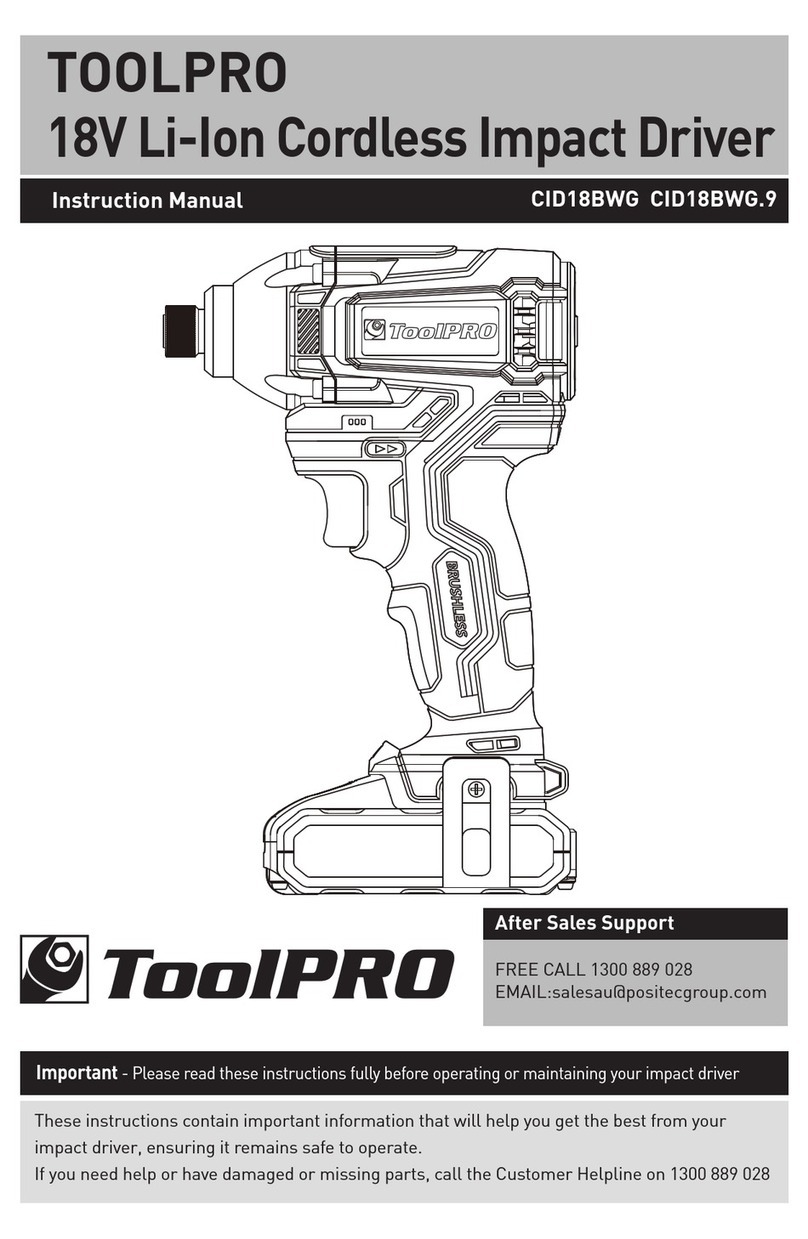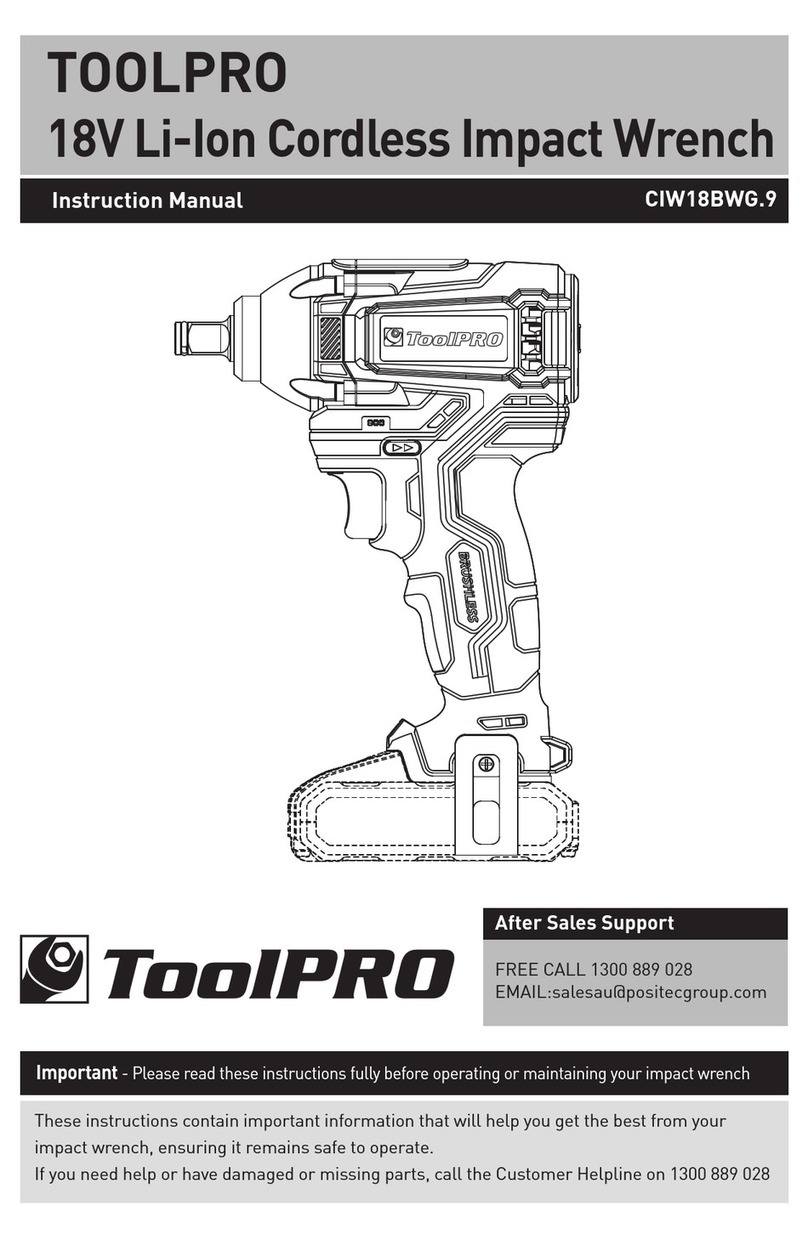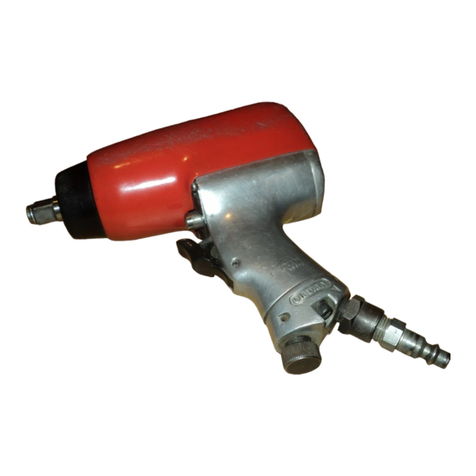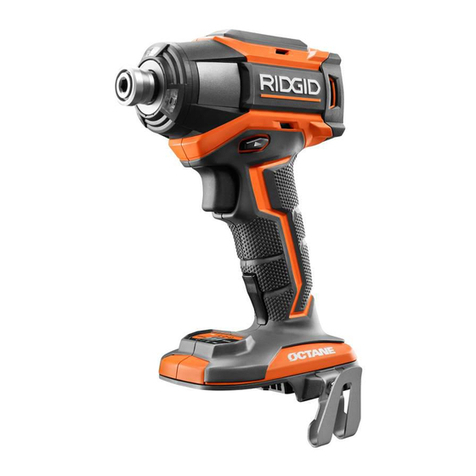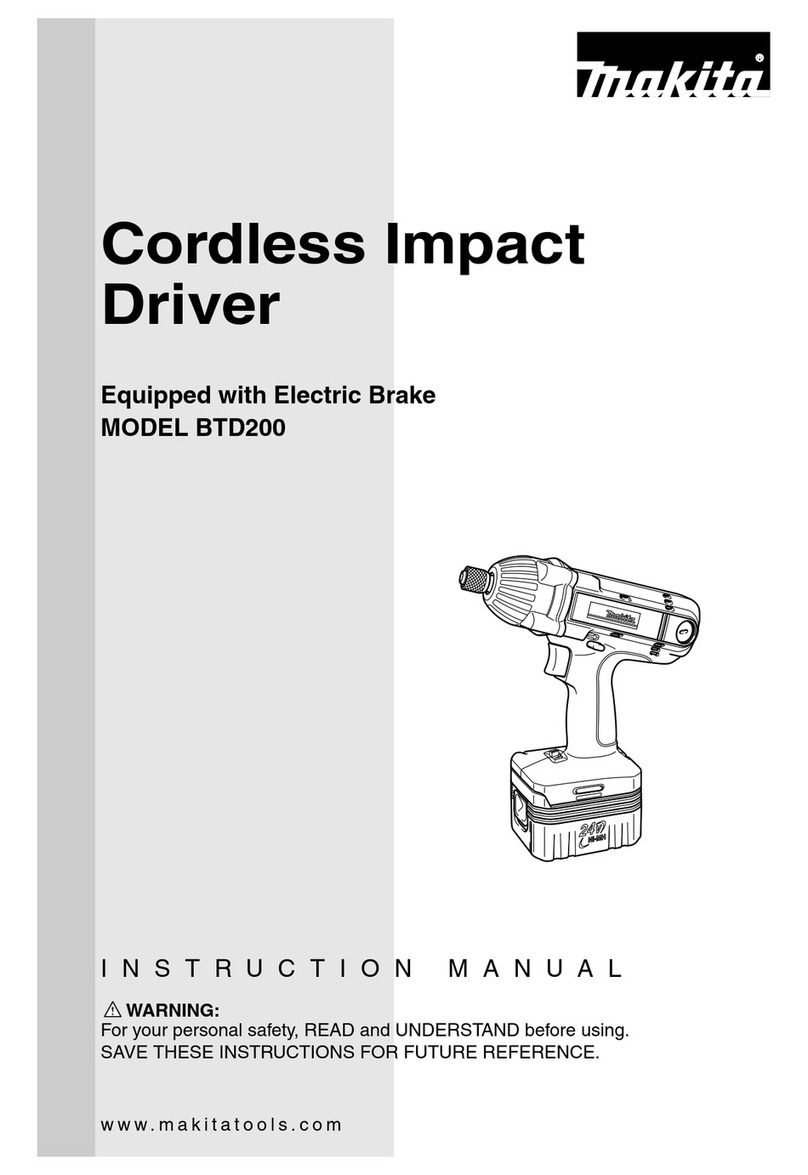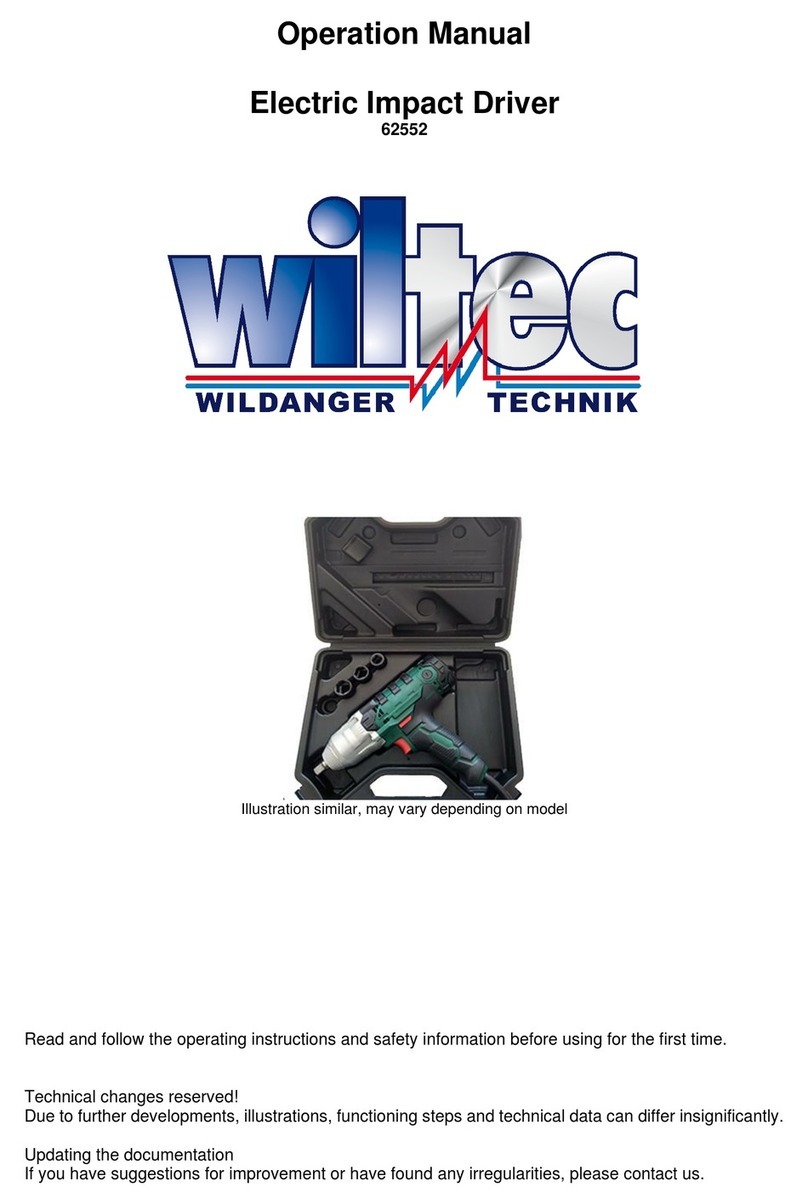ToolPRO CID18G.9 User manual

TOOLPRO
18V Li-Ion Cordless Impact Driver
Instruction Manual
Important - Please read these instructions fully before operating or maintaining your impact driver
These instructions contain important information that will help you get the best from your
impact driver, ensuring it remains safe to operate.
If you need help or have damaged or missing parts, call the Customer Helpline on 1300 889 028
After Sales Support
CID18G.9
FREE CALL 1300 889 028
EMAIL:salesau@positecgroup.com

Customer Helpline 1300 889 028
2
Contents
Safety Information.....................................................................................................3
In The Box..................................................................................................................8
Accessories...............................................................................................................8
Operating Instructions.............................................................................................. 9
Maintenance.............................................................................................................14
Technical Data..........................................................................................................15

Customer Helpline 1300 889 028
3
Safety Information
Important - Please read these instructions fully before starting assembly
Warning Symbols
To reduce the risk of injury, Please read the instruction manual
Warning
Wear ear protection Wear eye protection
Wear dust mask Indoor use only
Do not expose to rain or water Do not burn
Waste electrical products must not be disposed of with household waste. Please recycle
where facilities exist. Check with your local authorities or retailer for recycling advice.
Li-ion battery. This product has been marked with a symbol relating to ‘separate
collection’ for all battery packs and battery pack. It will then be recycled or
dismantled in order to reduce the impact on the environment. Battery packs can be
hazardous for the environment and for human health since they contain hazardous
substances.
Fuse
Positive terminal
Negative terminal
Read the operator’s manual
Double insulation
RCM marking
ABN: Australian Business Number. By this number, business information such as entity
type, status, business location etc. can be found at website http://abr.business.gov.au.
ABN of Positec Australia Pty Limited is 14 101 682 357
Li-I on Li-Ion

Customer Helpline 1300 889 028
4
WARNING! Read all safety warnings and all instructions. Failure to follow the
warnings and instructions may result in electric shock, fire and/or serious injury.
Save all warnings and instructions for future reference.
The term “power tool” in the warnings refers to your mains-operated (corded) power tool
or battery-operated (cordless) power tool.
1) Work area safety
a) Keep work area clean and well lit. Cluttered or dark areas invite accidents.
b) Do not operate power tools in explosive atmospheres, such as in the presence of
flammable liquids, gases or dust. Power tools create sparks which may ignite the
dust or fumes.
c) Keep children and bystanders away while operating a power tool. Distractions can
cause you to lose control.
2) Electrical safety
a) Power tool plugs must match the outlet. Never modify the plug in any way. Do not
use any adapter plugs with earthed (grounded) power tools. Unmodified plugs and
matching outlets will reduce risk of electric shock.
b) Avoid body contact with earthed or grounded surfaces, such as pipes, radiators,
ranges and refrigerators. There is an increased risk of electric shock if your body is
earthed or grounded.
c) Do not expose power tools to rain or wet conditions. Water entering a power tool will
increase the risk of electric shock.
d) Do not abuse the cord. Never use the cord for carrying, pulling or unplugging the
power tool. Keep cord away from heat, oil, sharp edges or moving parts. Damaged or
entangled cords increase the risk of electric shock.
e) When operating a power tool outdoors, use an extension cord suitable for outdoor
use. Use of a cord suitable for outdoor use reduces the risk of electric shock.
f) If operating a power tool in a damp location is unavoidable, use a residual
current device (RCD) protected supply. Use of an RCD reduces the risk of electric
shock.
3) Personal safety
a) Stay alert, watch what you are doing and use common sense when operating a
power tool. Do not use a power tool while you are tired or under the influence of
drugs, alcohol or medication. A moment of inattention while operating power tools
may result in serious personal injury.
b) Use personal protective equipment. Always wear eye protection. Protective
equipment such as dust mask, non-skid safety shoes, hard hat, or hearing protection
used for appropriate conditions will reduce personal injuries.
c) Prevent unintentional starting. Ensure the switch is in the off-position before
connecting to power source and/or battery pack, picking up or carrying the tool.
Carrying power tools with your finger on the switch or energising power tools that
have the switch on invites accidents.
Safety Information
Important - Please read these instructions fully before starting assembly
General Power Tool Safety Warnings

Customer Helpline 1300 889 028
5
d) Remove any adjusting key or wrench before turning the power tool on. A wrench or
a key left attached to a rotating part of the power tool may result in personal injury.
e) Do not overreach. Keep proper footing and balance at all times. This enables better
control of the power tool in unexpected situations.
f) Dress properly. Do not wear loose clothing or jewellery. Keep your hair, clothing
and gloves away from moving parts. Loose clothes, jewellery or long hair can be
caught in moving parts.
g) If devices are provided for the connection of dust extraction and collection facilities,
ensure these are connected and properly used. Use of dust collection can reduce
dust-related hazards.
4) Power tool use and care
a) Do not force the power tool. Use the correct power tool for your application.
The correct power tool will do the job better and safer at the rate for which it was
designed.
b) Do not use the power tool if the switch does not turn it on and off. Any power tool
that cannot be controlled with the switch is dangerous and must be repaired.
c) Disconnect the plug from the power source and/or the battery pack from the power
tool before making any adjustments, changing accessories, or storing power
tools. Such preventive safety measures reduce the risk of starting the power tool
accidentally.
d) Store idle power tools out of the reach of children and do not allow persons
unfamiliar with the power tool or these instructions to operate the power tool.
Power tools are dangerous in the hands of untrained users.
e) Maintain power tools. Check for misalignment or binding of moving parts, breakage
of parts and any other condition that may affect the power tool’s operation. If
damaged, have the power tool repaired before use. Many accidents are caused by
poorly maintained power tools.
f) Keep cutting tools sharp and clean. Properly maintained cutting tools with sharp
cutting edges are less likely to bind and are easier to control.
g) Use the power tool, accessories and tool bits etc. in accordance with these
instructions, taking into account the working conditions and the work to be
performed. Use of the power tool for operations different from those intended could
result in a hazardous situation.
5) Battery tool use and care
a) Recharge only with the charger specified by the manufacturer. A charger that is
suitable for one type of battery pack may create a risk of fire when used with another
battery pack.
b) Use power tools only with specifically designated battery packs. Use of any other
battery packs may create a risk of injury and fire.
c) When battery pack is not in use, keep it away from other metal objects, like paper
clips, coins, keys, nails, screws or other small metal objects, that can make a
connection from one terminal to another. Shorting the battery terminals together
may cause burns or a fire.
Safety Information
Important - Please read these instructions fully before starting assembly
General Power Tool Safety Warnings

Customer Helpline 1300 889 028
6
d) Under abusive conditions, liquid may be ejected from the battery; avoid contact. If
contact accidentally occurs, flush with water. If liquid contacts eyes, additionally seek
medical help. Liquid ejected from the battery may cause irritation or burns.
6) Service
Have your power tool serviced by a qualified repair person using only identical
replacement parts. This will ensure that the safety of the power tool is maintained.
Safety Information
Important - Please read these instructions fully before starting assembly
General Power Tool Safety Warnings
Additional safety warning for impact driver and impact wrench
1. Hold power tool by insulated gripping surfaces, when performing an operation
where the fastener may contact hidden wiring. Fasteners contacting a “live” wire
may make exposed metal parts of the power tool “live” and could give the operator
an electric shock.
a) Do not dismantle, open or shred cells or battery pack.
b) Do not short-circuit a battery pack. Do not store battery packs haphazardly in a
box or drawer where they may short-circuit each other or be short-circuited by
conductive materials. When battery pack is not in use, keep it away from other metal
objects, like paper clips, coins, keys, nails, screws or other small metal objects, that
can make a connection from one terminal to another. Shorting the battery terminals
together may cause burns or a fire.
c) Do not expose battery pack to heat or fire. Avoid storage in direct sunlight.
d) Do not subject battery pack to mechanical shock.
e) In the event of battery leaking, do not allow the liquid to come into contact with the
skin or eyes. If contact has been made, wash the affected area with copious amounts
of water and seek medical advice.
f) Seek medical advice immediately if a cell or battery pack has been swallowed.
g) Keep battery pack clean and dry.
h) Wipe the battery pack terminals with a clean dry cloth if they become dirty.
i) Battery pack needs to be charged before use. Always refer to this instruction and use
the correct charging procedure.
j) Do not maintain battery pack on charge when not in use.
k) After extended periods of storage, it may be necessary to charge and discharge the
battery pack several times to obtain maximum performance.
l) Battery pack gives its best performance when it is operated at normal room
temperature (20 °C ± 5 °C).
m) When disposing of battery packs, keep battery packs of different electrochemical
systems separate from each other.
n) Recharge only with the charger specified by manufacturer. Do not use any charger
other than that specifically provided for use with the equipment. A charger that is
suitable for one type of battery pack may create a risk of fire when used with another
battery pack.
o) Do not use any battery pack which is not designed for use with the equipment.
p) Keep battery pack out of the reach of children.
q) Retain the original product literature for future reference.
r) Remove the battery from the equipment when not in use.
s) Dispose of properly.
Safety Warnings for battery pack

Customer Helpline 1300 889 028
7
Safety Information
Important - Please read these instructions fully before starting assembly
General Safety Warnings for your battery charger
WARNING Read all safety warnings and all instructions. Failure to follow the
warnings and instructions may result in electric shock, fire and/or serious injury.
Save all warnings and instructions for future reference.
This appliance can be used by children aged from 8 years and above and persons with
reduced physical, sensory or mental capabilities or lack of experience and knowledge
if they have been given supervision or instruction concerning use of the appliance in a
safe way and understand the hazards involved. Children shall not play with the appliance.
Cleaning and user maintenance shall not be made by children without supervision.
If the supply cord is damaged, it must be replaced by the manufacturer, its service
agent or similarly qualified persons in order to avoid a hazard.
Additional safety instructions for your Battery Charger
1. Before charging, read the instructions.
2. For charge Li-ion battery pack only.
3. If the supply cord is damaged, it must be replaced by the manufacturer, its service
agent or similarly qualified persons in order to avoid a hazard.
4. The battery terminal not connected to the chassis has to be connected first. The
other connection is to be made to the chassis, remote from the battery and fuel line.
The battery charger is then to be connected to the supply mains.
5. After charging, disconnect the battery charger from the supply mains. Then remove
the chassis connection and then the battery connection.
6. Do not charge a leaking battery.
7. Do not use chargers for works other than those for which they are designed.
8. Before charging, ensure your charger is matching the local AC supply.
9. The charging device must be protected from moisture.
10.Do not use the charging device in the open.
11.Do not short out the contacts of battery or charger.
12.Respect the polarity “+/-“ when charging.
13.Do not open the unit and keep out of the reach of children.
14.Ensure that the connection between the battery charger and battery is correctly
positioned and is not obstructed by foreign bodies.
15.Keep battery charger’s slots free of foreign objects and protect against dirt and
humidity. Store in a dry and frost-free place.
16.When charging batteries, ensure that the battery charger is in a well-ventilated
area and away from inflammable materials. Batteries can get hot during charging.
Do not overcharge any batteries. Ensure that batteries and chargers are not left
unsupervised during charging.
17.Do not recharge non-rechargeable batteries, as they can overheat and break.
18.Longer life and better performance can be obtained if the battery pack is charged
when the air temperature is between 18oC and 24oC. Do not charge the battery pack
in air temperatures below 4.5oC , or above 40.5oC . This is important as it can prevent
serious damage to the battery pack.
19.Charge only battery pack of the same model provided by manufacturer and of
models recommended by manufacturer.

Customer Helpline 1300 889 028
8
In The Box
Parts
1
5
2
3
6
7
9
8
4
Forward/Reverse Rotating Control
On/Off Switch
Soft Grip Handle
Battery Pack (Not supplied)
Battery Pack Release Button
Belt Clip
Sight Light
Chuck
Battery Capacity Indicator
1
2
3
4
6
5
9
7
8
Accessories
Screwdriver bit 2
Belt clip 1

Customer Helpline 1300 889 028
9
Operating Instructions
NOTE: Before using the tool, read the instruction book carefully.
Intended Use
This tool is intended for the fastening and loosening of bolts, nuts and various threaded fasteners.
This tool is not intended for use as a drill.
1. CHARGING
We strongly recommend to use ToolPRO battery & charger kit. Please contact you local
Supercheap Auto store for more details or log onto www.supercheapauto.com.au for
Australia or www.supercheapauto.co.nz for New Zealand customers to find out more
details.
BEFORE PUTTING INTO OPERATION
CHARGING THE BATTERY PACK (SEE FIG. A)
NOTE:
a) The battery in your new tool is not charged when it leaves the plant. Therefore it must
be full charged before using the first time.
b) Do not use any charger other than that specifically provided for use with the equipment.
c) If the battery pack is very hot you must remove your battery pack from the charger and
allow time for the battery to cool down before recharging.
d) Please charge the battery to reach full or no less than half charge before storage. If the
tool will not be used for long periods of time, charge the battery every 3-6 months.
CHARGING PROCEDURE
1) Plug the charger into an appropriate outlet.
2) Place the battery pack into the charger
3) When charging is completed, unplug the charger and remove the battery pack.
Note: If the battery pack is locked in the charger, press the battery pack release button
and remove it.
WARNING: When battery charge runs out after continuous use or exposure to
direct sunlight or heat, allow time for the tool to cool down before re-charging to
achieve the full charge.

Customer Helpline 1300 889 028
10
Operating Instructions
CHARGING INDICATOR
1、Fast charger(See fig. A1)
Light ON/OFF flash Status
Red on Charging
Red flash - - - - - Defective Battery
Green on Fully Charged
Green flash - - - - - - Hot/Cold Delay
2、Slow charger(See fig. A2)
Light ON/OFF flash Status
Green flash - - - - - Charging
Green on Fully Charged
a
b
c
A1 A2
B C
D
E F

Customer Helpline 1300 889 028
11
Operating Instructions
2. INSTALLING AND REMOVING THE BATTERY PACK
a) TO REMOVE THE BATTERY PACK (SEE FIG B1)
Depress the Battery Pack Release Button(5) firmly first and then slide the Battery
Pack out from your tool.
b) TO INSTALL THE BATTERY PACK (SEE FIG B2)
Slide the fully charged Battery Pack onto the tool with sufficient force until it clicks
into position.
3. INSERTING A BIT HOLDER, SOCKET OR SCREWDRIVER BIT (SEE FIG C)
Pull the Chuck Sleeve (b) forward. Fully insert the desired bit into the chuck and
release the Chuck Sleeve.
Note: Try to pull the bit after releasing the Chuck Sleeve to make sure the bit is fully
locked in the chuck.
4. REMOVING A BIT HOLDER, SOCKET OR SCREWDRIVER BIT (SEE FIG D)
Pull the Chuck Sleeve (b) forward. Take the bit out of the Chuck (a) and release the
Chuck Sleeve.
B1
C
B2
D
a b
a b
a b
a b

Customer Helpline 1300 889 028
12
Operating Instructions
5. REVERSIBLE (SEE FIG E1, E2)
For drilling and screw driving use forward rotation marked “ ” (lever is moved to the
left). Only use reverse rotation marked “ ” (lever is moved to the right) to remove
screws or release a jammed drill bit.
WARNING: Never change the direction of rotation when the chuck is rotating, wait
until it has stopped!
6. SWITCH LOCK (SEE FIG F)
The switch trigger can be locked in the OFF position. This helps to reduce the possibility
of accidental starting when not in use. To lock the switch trigger, place the rotation
control in the center position.
7. ON/OFF SWITCH (SEE FIG G)
Depress to start and release to stop your driver.
The On/Off Switch is fitted with a brake function which stops your chuck immediately
when you quickly release the switch.
It is also a variable speed switch that delivers higher speed and torque with increased
trigger pressure. Speed is controlled by the amount of switch trigger depression.
WARNING: Do not operate for long periods at low speed because excess heat will
be produced internally.
E1
F
E2
G

Customer Helpline 1300 889 028
13
Operating Instructions
8. USING THE SIGHT LIGHT
To turn on the light, press the on/off switch and make sure the forward/reverse
rotation control is on right/left position. When you release the on/off switch, the light
will be off.
LED lighting increases visibility-great for dark or enclosed area.
9. Battery Capacity Indicator
Your tool is equipped with Battery Capacity Indicator. Press the On/Off Switch halfway
or fully, the Battery Capacity Indicator will light up to show the amount of charge left
in the battery.
Fuel Gauge Capacity
3 lights >70%
2 lights >40%
1 light <40%
1 flashing light Recharge battery
10. BELT CLIP (SEE FIG H1, H2)
Screw the Belt Clip (6) on the tool with the screw provided in the plastic bag. The Belt
Clip can be cliped on your belt or pocket, etc.
11. OVERLOAD PROTECTION
When overloaded, the motor comes to a stop. Relieve the load on the tool immediately
and release the on/off switch. Restart the tool as normal.
12. TEMPERATURE DEPENDENT OVERLOAD PROTECTION
When using as intended for the power tool cannot be subject to overload. When
the load is too high or the allowable battery temperature of 75 °C is exceeded, the
electronic control switches off the power tool until the temperature is in the optimum
temperature range again.
H1 H2

Customer Helpline 1300 889 028
14
Operating Instructions
13. PROTECTION AGAINST DEEP DISCHARGING
The Li-ion battery is protected against deep discharging by the “Discharging Protection
System”. When the battery is empty, the tool is switched off by means of a protective
circuit: The inserted tool no longer rotates.
14. DISPOSAL OF AN EXHAUSTED BATTERY PACK
To preserve natural resources, please recycle or dispose of the battery pack
properly. This battery pack contains Lithium batteries. Consult your local waste
authority for information regarding available recycling and/or disposal options.
Discharge your battery pack by operating your drill, then remove the battery pack from
the drill housing and cover the battery pack connections with heavy-duty adhesive tape
to prevent short circuit and energy discharge. Do not attempt to open or remove any of
the components.
Maintenance
Your power tool requires no additional lubrication or maintenance.
There are no user serviceable parts in your power tool. Never use water or chemical
cleaners to clean your power tool. Wipe clean with a dry cloth. Always store your power
tool in a dry place. Keep the motor ventilation slots clean. Keep all working controls free
of dust. Occasionally you may see sparks through the ventilation slots. This is normal
and will not damage your power tool.

Customer Helpline 1300 889 028
15
Staple your purchase receipt here
Before returning this product for
warranty or any other reason, please call.
POSITEC AUSTRALIA PTY LIMITED
ABN 14 101 682 357
Unit 15, 23 Narabang Way Belrose 2085 NSW Australia
FREE CALL 1300 889 028
EMAIL:sales[email protected]
Technical Data
Technical Data Table
Voltage 18 V
Rated No-load speed 0-2400 /min
Impact rate 0-3000 / min
Max torque 140N.m
Chuck size 6.35mm hex
Charger voltage 100 – 240 V ~ 50/60 Hz
Battery capacity 1.5Ah Samsung Li-ion battery (27Wh)
Machine Weight 1.42kg (Including battery)
Charging time 1-1.5hr by fast charger,
3-5hrs by slow charger
Charger Input 100-240V~50/60Hz
Charger Output 10.8~20V 1.5A by fast charger
10.8--20V 400mA by slow charger
Battery capacity 1.5/2.0Ah Li-ion battery

Table of contents
Other ToolPRO Impact Driver manuals
Popular Impact Driver manuals by other brands
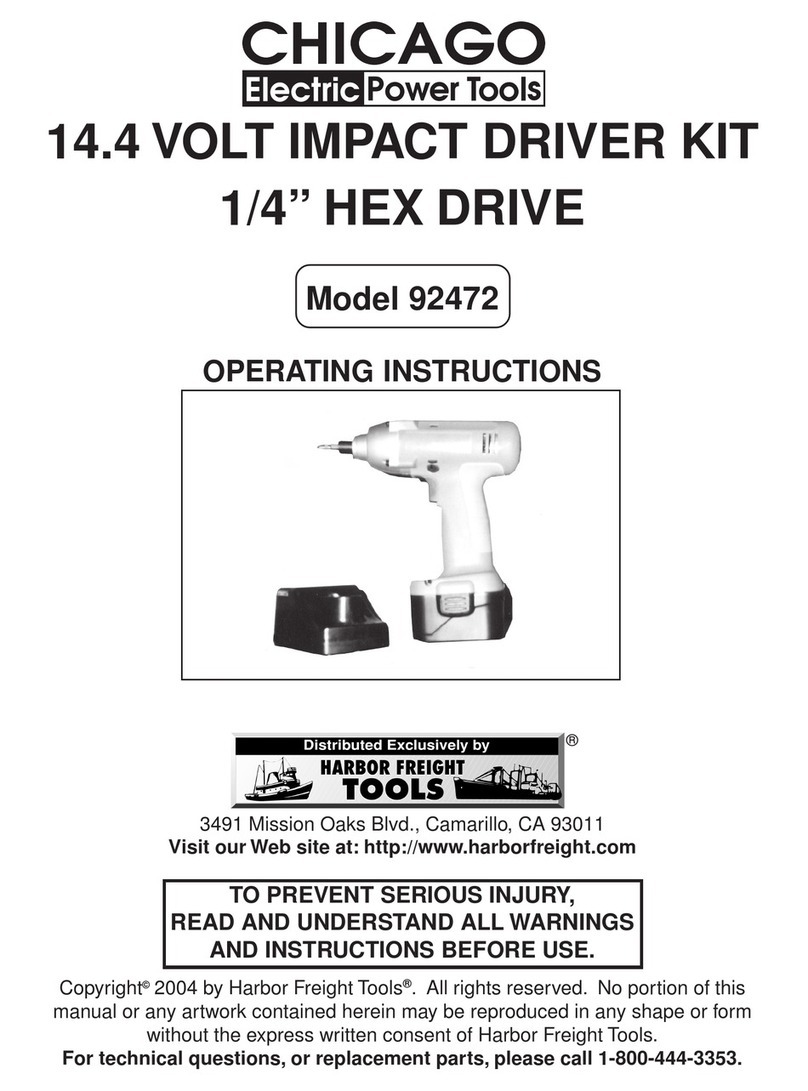
Chicago Electric
Chicago Electric 92472 operating instructions
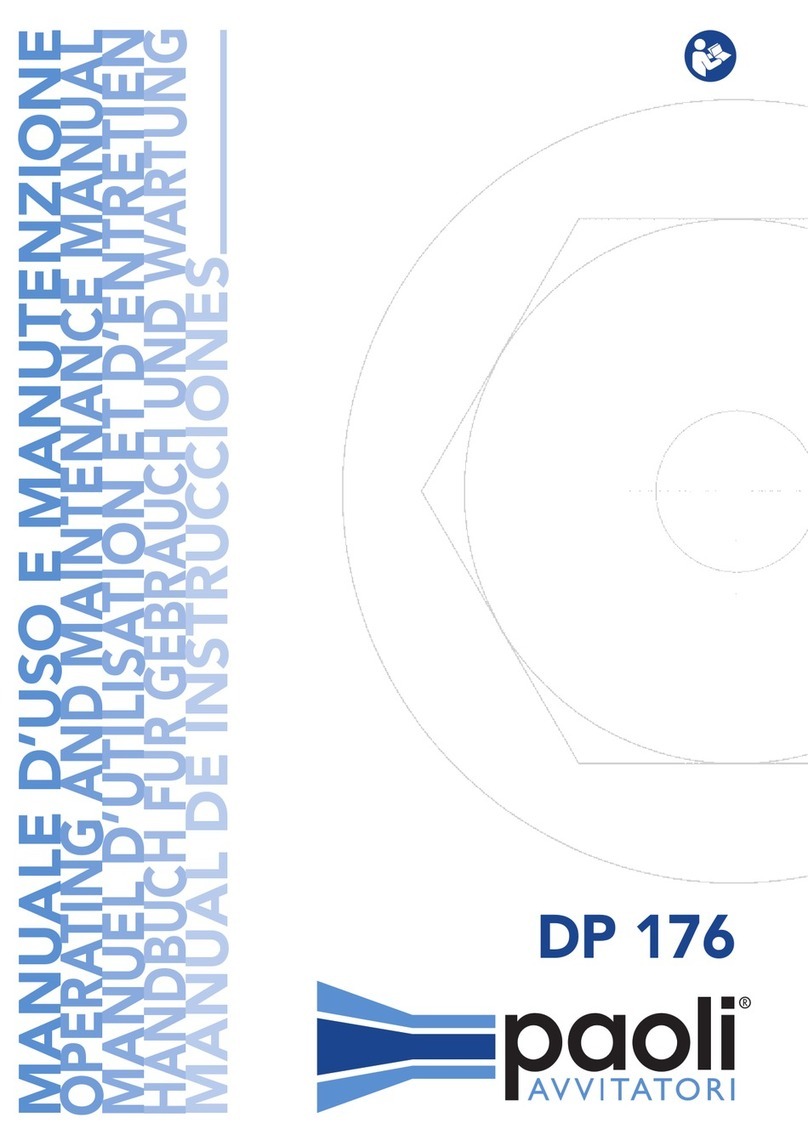
Paoli Avvitatori
Paoli Avvitatori DP 176 Operating and maintenance manual

RODCRAFT
RODCRAFT 8951000085 manual
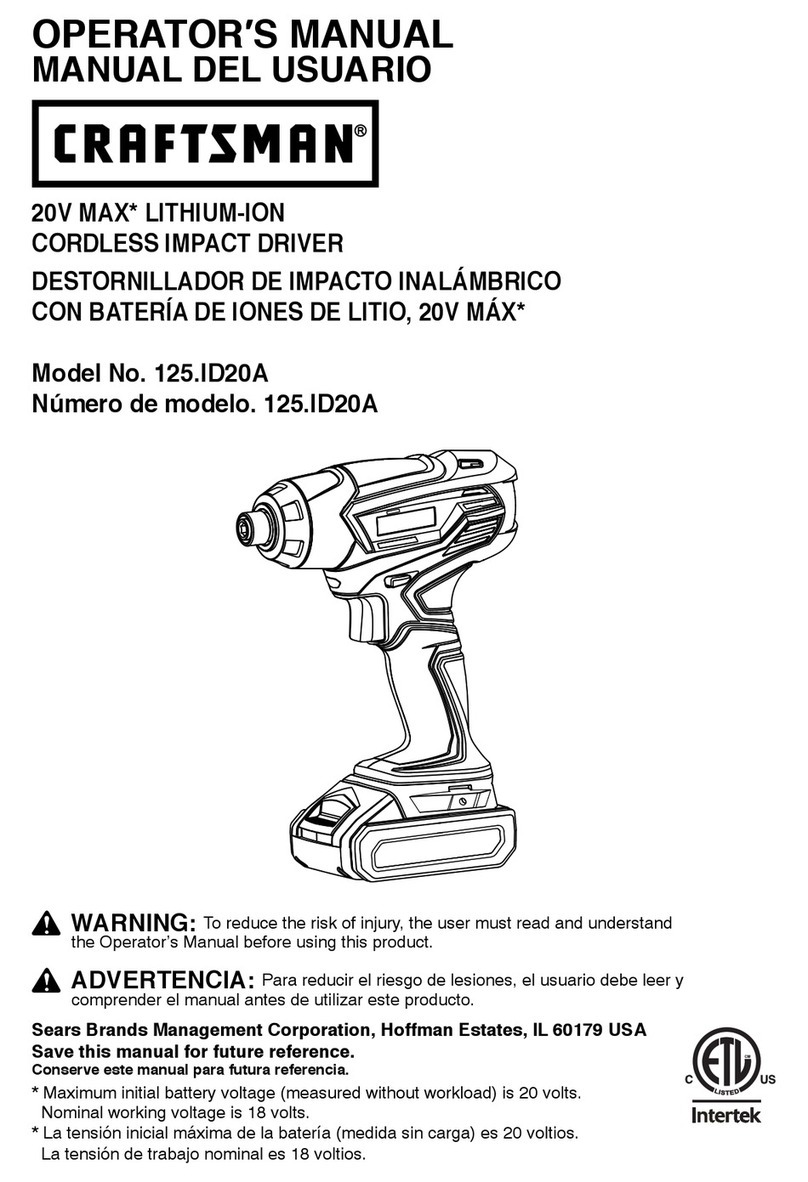
Craftsman
Craftsman 125.ID20A Operator's manual
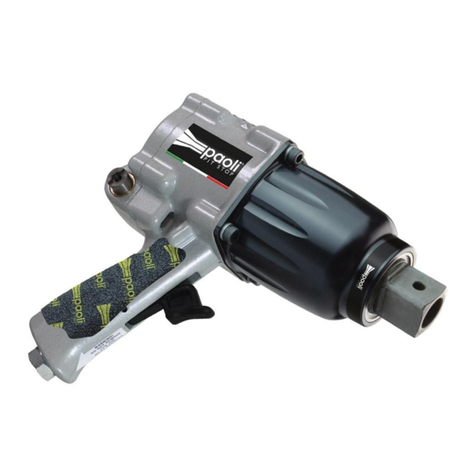
Paoli
Paoli DP 2000 SE Operating and maintenance manual
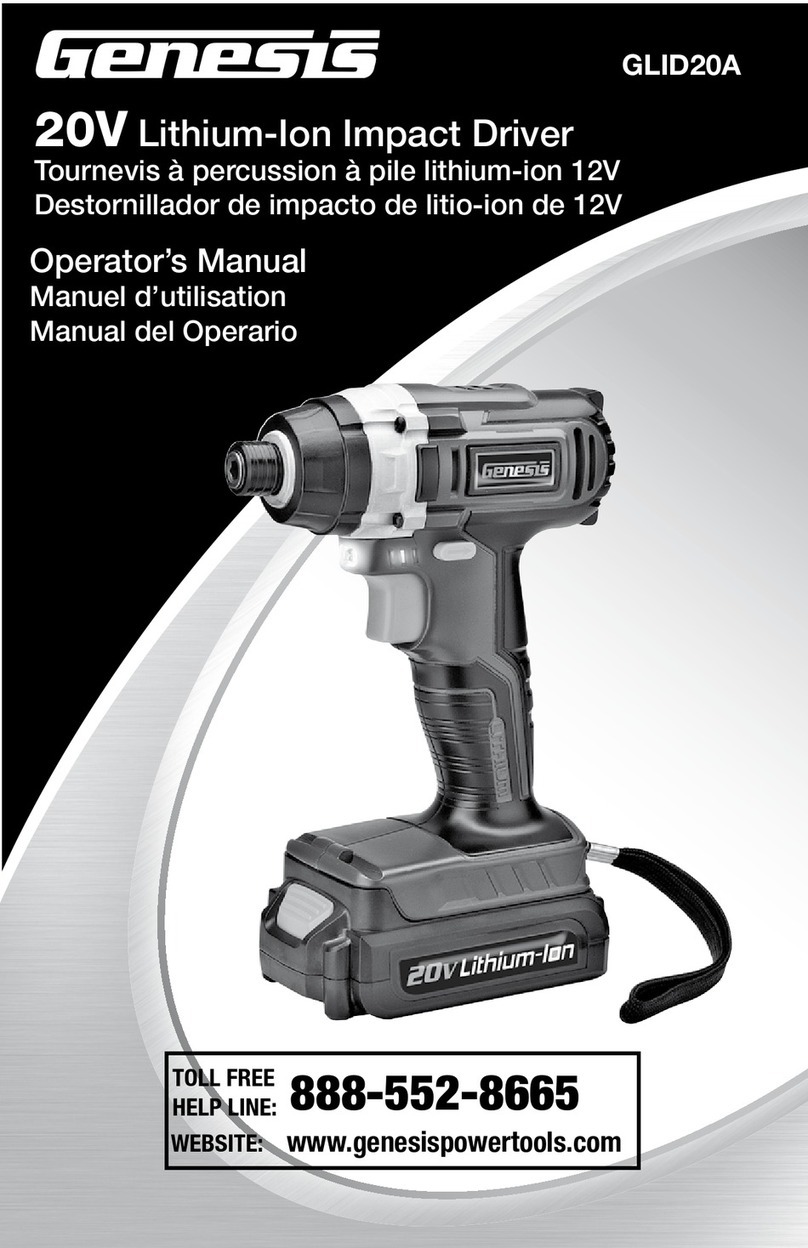
Genesis
Genesis GLID20A Operator's manual

Beta
Beta 1927PAL Operation manual and instructions

Chicago Pneumatic
Chicago Pneumatic CP7763 Series Operator's manual

Rockwell
Rockwell RK2611K2 instruction manual
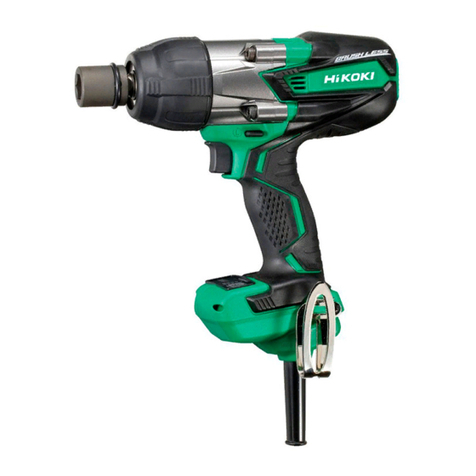
HIKOKI
HIKOKI WR 14VE Handling instructions
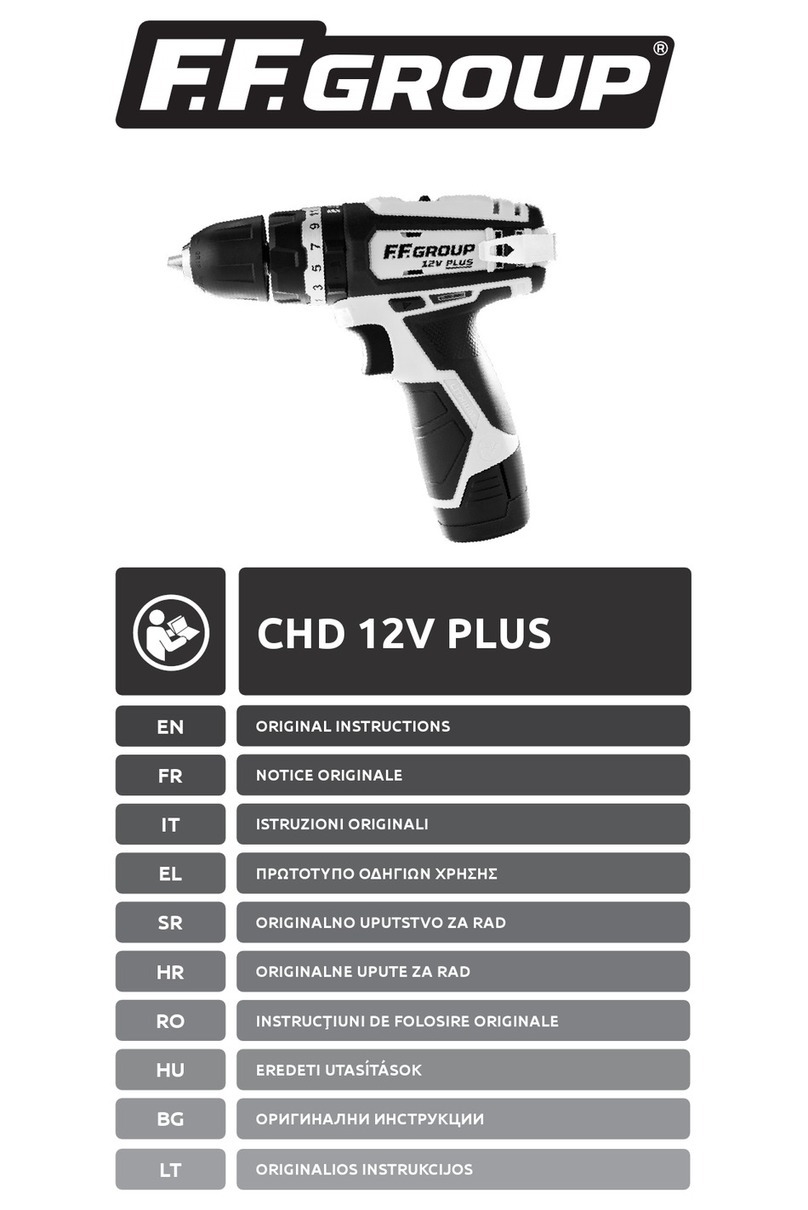
F.F. Group
F.F. Group CHD 12V PLUS Original instructions
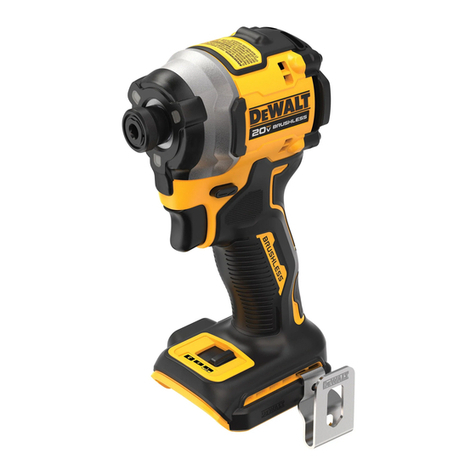
DeWalt
DeWalt DCF850NT Original instructions
